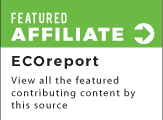

A University of Cincinnati scientist has engineered an environmentally friendly technology to zap outbreak-causing viruses and bacteria from public drinking water.
Environmental and biomedical engineer David Wendell, an associate professor in UC’s College of Engineering and Applied Science, developed a protein-based photocatalyst that uses light to generate hydrogen peroxide to eliminate E. coli, Listeria, and potentially protozoa like giardia and cryptosporidium.
If mass produced, he predicts this protein (called StrepMiniSog) could be used to safely “spike” the public water supply in the event of an outbreak.
“We designed this protein to attach to pathogens of interest using antibodies, so that when the attached photocatalyst is exposed to light it generates hydrogen peroxide and kills the pathogen,” said Wendell.
Continue reading at: University of Cincinnati
Image credit: David Wendell
Terms of Use | Privacy Policy
2016©. Copyright Environmental News Network




